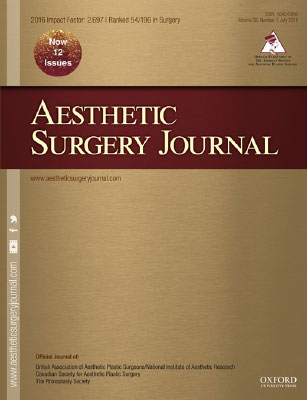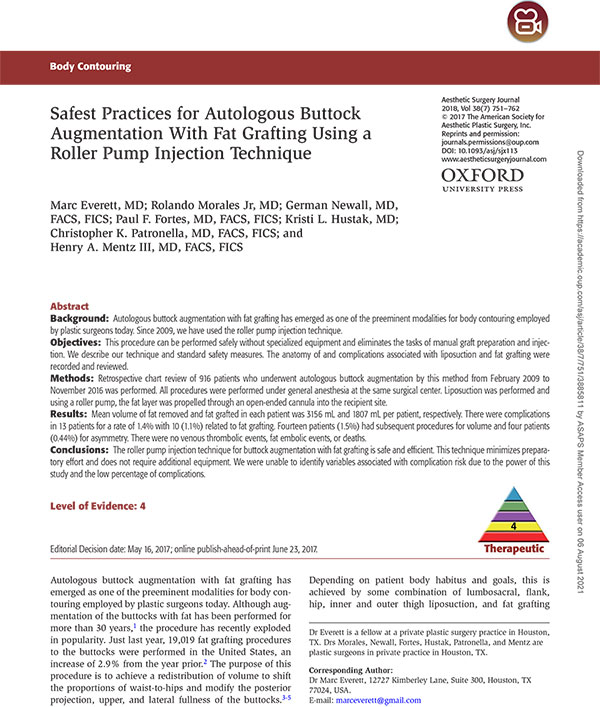Safest Practices for Autologous Buttock Augmentation With Fat Grafting Using a Roller Pump Injection Technique
 Dr. Patronella was invited to contribute to a study evaluating the safest, more reliable techniques for fat transfer buttock augmentation (Brazilian Butt Lift — BBL). This study used the roller pump injection technique, a variation that eliminates the need for manual graft preparation and injection.
Dr. Patronella was invited to contribute to a study evaluating the safest, more reliable techniques for fat transfer buttock augmentation (Brazilian Butt Lift — BBL). This study used the roller pump injection technique, a variation that eliminates the need for manual graft preparation and injection.
Our practice has seen a dramatic increase in the number of patients wishing for autologous buttock augmentation as well as an increase in the volume required to meet their goals. The roller pump injection technique has helped us to be able to meet this demand by facilitating large volume fat grafting in a way that is both rapid and safe. The setup for this method is completed in under a minute and can be performed at any time in the sterile field. The minimal manipulation required to prepare the graft also takes less than a minute and therefore does not occupy a surgical assistant during time under anesthesia for any longer than that.
Our dataset begins with the start of our experience with the roller pump injection technique. Since utilization of this method for all patients undergoing buttock augmentation with fat in 2009, we have gone from 58 cases in that first year to 178 this year with two months left remaining. Figure 1 shows the overall trend of volume injected has steadily increased, starting with an average of 1290 mL total graft in 2009 up to 2004 mL total graft today. This mirrors the trends from the series published by Cardenas- Camarena et al6 in which they demonstrated the progression in their experience in different phases. There were no patients in their series that had more than 500 mL per buttock grafted in the initial phase of the study and then by the time the accrual of their last phase had concluded, there was a considerable constituent with 501 to 1160 mL grafted per side. As demonstrated by the increase in the number of cases and average amount of graft volumes over the course of our experience, we affirm that there is an evolution in buttock aesthetics. Demands for higher volumes are influenced by the increasing awareness of the “Brazilian Butt Lift” from popular culture and through social media. At the time that this manuscript is being prepared, there are 157,652 hashtags for “BBL” and 39,998 for “Brazilian Butt Lift” on Instagram alone and 3,510,000 results on Google for the search “celebrity Brazilian Butt Lift.”
 Patient satisfaction with this technique has been validated by survey12,13 and is also evident in our hands by the low revision rate. Though we did not otherwise measure patient-reported outcomes. Since implementing the roller pump injection technique, only 18 patients (1.96%) have opted to repeat the procedure and one additional patient is planning to in the future. Three patients had asymmetry after the procedure and one patient had a preoperative contour deformity that went undercorrected and remained persistent through the first operation. One patient who was found to have a lateral contour flattening early in the postoperative period was identified as a side-sleeper. We would recommend that patients who are known to sleep on one side should sleep in the supine position with a pillow beneath their knees for the first two weeks to prevent turning during sleep. Otherwise, we do not implement a postoperative regimen of positioning, we simply advise patients to ambulate frequently during the day and make a conscious effort to shift their weight often when at rest. Of the 14 patients who had revisions secondary to patient preference for greater volume, about half of these patients underwent their initial operation early in our experience with this technique and their total graft volumes were less than 1000 mL per buttock. This, combined with lower volume goals set by patients years ago, would explain why this subset of patients returned for a second procedure.
Patient satisfaction with this technique has been validated by survey12,13 and is also evident in our hands by the low revision rate. Though we did not otherwise measure patient-reported outcomes. Since implementing the roller pump injection technique, only 18 patients (1.96%) have opted to repeat the procedure and one additional patient is planning to in the future. Three patients had asymmetry after the procedure and one patient had a preoperative contour deformity that went undercorrected and remained persistent through the first operation. One patient who was found to have a lateral contour flattening early in the postoperative period was identified as a side-sleeper. We would recommend that patients who are known to sleep on one side should sleep in the supine position with a pillow beneath their knees for the first two weeks to prevent turning during sleep. Otherwise, we do not implement a postoperative regimen of positioning, we simply advise patients to ambulate frequently during the day and make a conscious effort to shift their weight often when at rest. Of the 14 patients who had revisions secondary to patient preference for greater volume, about half of these patients underwent their initial operation early in our experience with this technique and their total graft volumes were less than 1000 mL per buttock. This, combined with lower volume goals set by patients years ago, would explain why this subset of patients returned for a second procedure.
Even though we have found an increasing amount of total volume of fat grafting over time, we do not show a trend of increasing volumes of liposuction across the population to match this, nor is there a relationship between the amount of liposuction and the amount of fat grafting performed on each individual patient. In some patients, the maximum amount of fat grafting performed is limited by the amount of fat provided by liposuction. In others, the volume of fat grafted is capped by the buttocks capacitance to receive fat, or by patient desire for subtle augmentation and there is often volume of graft left to be discarded. Cardenas et al do not recommend overcorrection of the buttock aesthetic, they recommend optimal contour on table because they feel that overcorrection leads to fat necrosis.6 Many of our patients request that we achieve the largest volume of grafting possible and as our comfort has grown with this concept, we often reach the point of maximal capacitance in each buttock while maintaining the patients’ desired buttock shape (Figures 5 and 6 and Supplemental Figure 1, available online at www. aestheticsurgeryjournal.com). Despite this, we have only discovered three (0.33%) clinically detectible cysts and four (0.44%) cases of postoperative asymmetry requiring intervention.
The rate of complications that we have shown in our series, 1.4%, is lower than that previously established in the literature by any single center or meta-analysis. Recent meta-analyses reporting complication rates of 9.9%22 and 7%23 include low volume studies and centers reporting earlier experiences. Despite having treated over 900 patients, we were unable to identify specific variables associated with elevated complication risk due to the power of this study and the low percentage of complications overall and within groups. We attribute our low complication rate to strict adherence to the safety standards that govern our practice. These standards are created by a set of guidelines that apply to preoperative, intraoperative, and postoperative decision making. Patients are warmed with forced air gowns and hydrated with intravenous fluids ahead of the operation in the preoperative holding area. Patients identified preoperatively as high risk for DVT by the assessment model created by Caprini31 and validated for plastic surgery patients by Pannucci et al,32 undergoing multiple or high risk procedures, or have high volume liposuction are started on either oral or injectable prophylactic anticoagulation on postoperative day 1 as per our routine.30 These patients are also kept overnight in our facility for observation. Sterile sequential compression devices are applied to the calves on all patients during the operation and patients are encouraged to ambulate every two hours postoperatively. There were no suspected or confirmed DVTs or PEs in the study population.
Fat embolism is the most devastating complication in buttock augmentation with fat grafting and we have been fortunate not to have seen this pathology first hand.33 Last year, Cardenas-Camarena et al compiled a thorough examination of a group of patient mortalities in Mexico and Colombia sustained over the past 15 years.25 They describe the pathology as either a macroscopic or microscopic process, which have different mechanisms of infiltration and injury, presenting times and symptomatology, and may result in different outcomes. In this review, it was found that 19 of 27 deaths occurred intraoperatively and the remaining 8 occurred within the first 24 hours. Therefore, early recognition is essential to provide supportive care as soon as possible to attempt to alter the outcome of this process.
The average amount of fat grafted in the mortality group was just 214 mL per buttock. Some of the autopsies demonstrated macroscopic fat in the vena cava, heart, and lungs. Fat globules found in the gluteus muscle was a common finding. In early techniques, this was intentional. This comes as no surprise as Guerrerosantos has shown in both animal and clinical models show better take of fat grafting if infiltrated into a highly vascular bed such as muscle tissue. 34-37 It was not initially considered that this would be suspected as the route for infiltration for microscopic fat emboli or the proximity allowing injury to the gluteal vessels permitting macroscopic fat emboli. In the cases of macroscopic fat embolism and on-table death, traumatic injury to the gluteal vein was identified on autopsy.25 The gluteal veins enters the pelvis through the greater sciatic foramen and converge into the internal iliac vein.
For a patient in the lateral or prone position, this foramen is open towards the inferior direction. The gluteal veins are thus vulnerable to injury as they enter the foramen by a cannula passed from an inferior to superior direction. When the cannula is passed into the buttock from a superior to inferior direction, access to the foramen is shielded by the ileum and by a network of connective ligaments (Figure 7). In order to reduce risk of causing microscopic fat embolic syndrome, our intent is to avoid injection of fat into the gluteus muscles. To reduce risk of occlusive macroscopic fat emboli, injection is only performed in the tissue superficial to the muscle, using a 4-mm or 5-mm cannula from incisions at the superior margin of the buttocks in a superior to inferior direction to avoid direct injury to the large bore veins entering the pelvis. We also no longer use an open-ended cannula for grafting, replacing it with a rounded-tip basket cannula only.
These safety measures have been our standard of practice and are inclusive but not limited to the recommendations recently published by the Aesthetic Society Education and Research Foundation (ASERF) Task Force on Mortality from Gluteal Fat Grafting.38 Prevention of seroma is directed mainly at fat harvest locations by employing compression garment strategies and by leaving incisions for liposuction and fat grafting open to drain. With just a few moments of gentle pressure, the fat grafting sites do not have loss of the fat graft. The liposuction incisions may drain a copious amount over the first 24 hours and may persist to drain lesser amounts over the next 48 to 72 hours. This is by intention as coupled with compression garments selected to cover appropriate regions, the body is tasked with having less fluid to have to resorb and thus lowering the likelihood of seroma. Klein found that this strategy also resulted in fewer incidences of panniculitis by not only encouraging the rapid drainage of residual tumescent fluid but also the elimination of proinflammatory postsurgical subcutaneous exudate.39 To further control the incidence of postoperative infections, we have employed a number of strategies.
Each patient is provided with chlorhexidine soap and instructed to use for whole body the night before and morning of the procedure. When the patients arrive to the surgery center, they are then to use chlorhexidine wipes across the whole body in the preoperative preoperative dressing area. We then perform a standing, circumferential prep with chlorhexidine scrub and the incision sites are treated with chlorhexidine alcohol-based prep after the time-out is performed. Appropriate intravenous antibiotics are administered prior to initiation of the case. Prior to fat injection, 1 gram of cephalexin is added to each canister of lipoaspirate after evacuation of settled liquid. Additionally, the minimal manipulation and closed nature of the roller pump injection system limits exposure to any equipment or surfaces outside of the circuit. Regarding the use of steroids in the tumescent solution, Klein no longer includes the triamcinolone that was part of the original tumescent formulation and caveats the possible increased risk of infection secondary to steroid-induced impairment of immune function. 39 We believe the observed benefit of reduced soreness and bruising outweighs the potential risk infection and we continue to include it in our tumescent formula.
The purpose of this study was to introduce our methods for achieving fat grafting to the buttocks and demonstrate that when performed with certain safety measures in mind, the minor complication rate is low and major complications can be avoided. This study did not assess graft retention rate, or compare outcomes against other methods of performing this procedure. MRI or 3-dimensional topographic studies would be feasible, although expensive methods that could be utilized to compare these outcomes. We did not directly measure patient satisfaction by means of survey, although others have in the past and demonstrated high patient satisfaction rates.12,13 We assume patient satisfaction based on the increasing number of procedures performed each year by our group by referral, our low overall revision rate, and our patients return for additional nonrelated procedures and continue with spa services.
Our patients are routinely seen during the first six months after the procedure, but many do not return beyond that. Some patients are lost to follow up earlier than several months and others have been seen and photographed as far as seven-years postoperative. We have a large constituency of patients who travel to our practice for the procedure and leave the city after an initial postoperative check. Patients that are either from out of town and leave after initial postoperative check or those whom are lost to follow up earlier than anticipated may cause an underreporting of some complications such as asymmetry but major complications such as occlusive fat embolism, fat emboli syndrome, pulmonary embolism, deep vein thrombosis, sepsis, dehydration, and infection would all have occurred during the period in which all patients are still under our care. Long-term (multiple year) patient satisfaction has not been thoroughly studied in buttock fat grafting performed by any method and considering the current popularity of the procedure, we as a community should aim to do so to continue to refine our techniques for future patients.
CONCLUSION
For the last seven years, we have performed our gluteal augmentation with fat grafting using the roller pump injection technique. This method of lipoinjection is safe and both time and cost saving, requiring little in terms of specialized equipment and spending less time in the operating room reducing the amount of time spent under anesthesia. Our complication rate is low because of strict adherence to safety measures inclusive of, but not limited to, those recommended by the ASERF Task Force.38 Despite being the largest series found in the literature to date, our complication rate is low, and additional randomized, prospective and multicenter studies would be required to identify risk factors associated with elevated complication risk.


